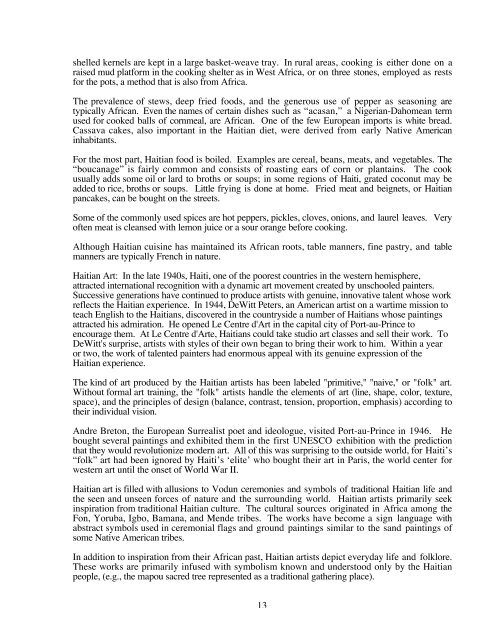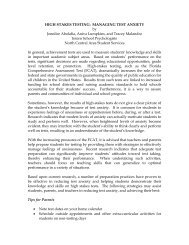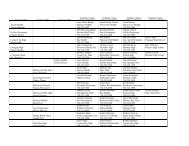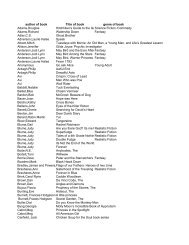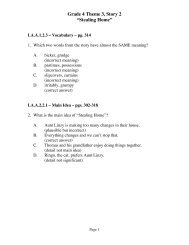Haitian Culture Curriculum Guide
Haitian Culture Curriculum Guide
Haitian Culture Curriculum Guide
You also want an ePaper? Increase the reach of your titles
YUMPU automatically turns print PDFs into web optimized ePapers that Google loves.
shelled kernels are kept in a large basket-weave tray. In rural areas, cooking is either done on a<br />
raised mud platform in the cooking shelter as in West Africa, or on three stones, employed as rests<br />
for the pots, a method that is also from Africa.<br />
The prevalence of stews, deep fried foods, and the generous use of pepper as seasoning are<br />
typically African. Even the names of certain dishes such as “acasan,” a Nigerian-Dahomean term<br />
used for cooked balls of cornmeal, are African. One of the few European imports is white bread.<br />
Cassava cakes, also important in the <strong>Haitian</strong> diet, were derived from early Native American<br />
inhabitants.<br />
For the most part, <strong>Haitian</strong> food is boiled. Examples are cereal, beans, meats, and vegetables. The<br />
“boucanage” is fairly common and consists of roasting ears of corn or plantains. The cook<br />
usually adds some oil or lard to broths or soups; in some regions of Haiti, grated coconut may be<br />
added to rice, broths or soups. Little frying is done at home. Fried meat and beignets, or <strong>Haitian</strong><br />
pancakes, can be bought on the streets.<br />
Some of the commonly used spices are hot peppers, pickles, cloves, onions, and laurel leaves. Very<br />
often meat is cleansed with lemon juice or a sour orange before cooking.<br />
Although <strong>Haitian</strong> cuisine has maintained its African roots, table manners, fine pastry, and table<br />
manners are typically French in nature.<br />
<strong>Haitian</strong> Art: In the late 1940s, Haiti, one of the poorest countries in the western hemisphere,<br />
attracted international recognition with a dynamic art movement created by unschooled painters.<br />
Successive generations have continued to produce artists with genuine, innovative talent whose work<br />
reflects the <strong>Haitian</strong> experience. In 1944, DeWitt Peters, an American artist on a wartime mission to<br />
teach English to the <strong>Haitian</strong>s, discovered in the countryside a number of <strong>Haitian</strong>s whose paintings<br />
attracted his admiration. He opened Le Centre d'Art in the capital city of Port-au-Prince to<br />
encourage them. At Le Centre d'Arte, <strong>Haitian</strong>s could take studio art classes and sell their work. To<br />
DeWitt's surprise, artists with styles of their own began to bring their work to him. Within a year<br />
or two, the work of talented painters had enormous appeal with its genuine expression of the<br />
<strong>Haitian</strong> experience.<br />
The kind of art produced by the <strong>Haitian</strong> artists has been labeled "primitive," "naive," or "folk" art.<br />
Without formal art training, the "folk" artists handle the elements of art (line, shape, color, texture,<br />
space), and the principles of design (balance, contrast, tension, proportion, emphasis) according to<br />
their individual vision.<br />
Andre Breton, the European Surrealist poet and ideologue, visited Port-au-Prince in 1946. He<br />
bought several paintings and exhibited them in the first UNESCO exhibition with the prediction<br />
that they would revolutionize modern art. All of this was surprising to the outside world, for Haiti’s<br />
“folk” art had been ignored by Haiti’s ‘elite’ who bought their art in Paris, the world center for<br />
western art until the onset of World War II.<br />
<strong>Haitian</strong> art is filled with allusions to Vodun ceremonies and symbols of traditional <strong>Haitian</strong> life and<br />
the seen and unseen forces of nature and the surrounding world. <strong>Haitian</strong> artists primarily seek<br />
inspiration from traditional <strong>Haitian</strong> culture. The cultural sources originated in Africa among the<br />
Fon, Yoruba, Igbo, Bamana, and Mende tribes. The works have become a sign language with<br />
abstract symbols used in ceremonial flags and ground paintings similar to the sand paintings of<br />
some Native American tribes.<br />
In addition to inspiration from their African past, <strong>Haitian</strong> artists depict everyday life and folklore.<br />
These works are primarily infused with symbolism known and understood only by the <strong>Haitian</strong><br />
people, (e.g., the mapou sacred tree represented as a traditional gathering place).<br />
13


